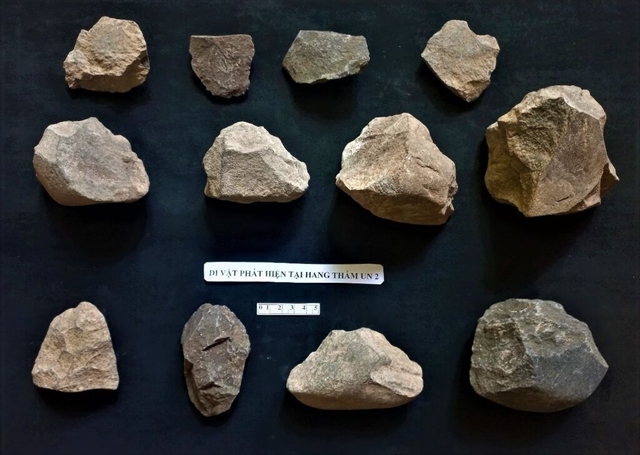 Society
Society

 |
| ON SHOW: People including children watch the artefacts found under the water of Cù Lao Chàm Island, Quảng Nam Province. Photo hoianrt.vn |
A lack of qualified human resources, equipment and funding, as well as increasing theft of antiques from shipwrecks, are hindering the protection and preservation of underwater relics, leading archaeologists have said.
Đinh Thị Thanh Nga from the Việt Nam Centre for Underwater Archaeology said the country was lacking experts well-trained in research, conservation, and preservation of maritime artefacts while speaking at a preliminary consultation workshop on maritime heritage held by the Ministry of Culture, Sports and Tourism in coordination with the UNESCO Office in Việt Nam.
She said many archaeologists in the country did not directly participate in the excavation of shipwrecks, but monitored the work via control screens and examined the artefacts only after they were brought on land.
 |
| ANCIENT TREASURE: Artefacts from a shipwreck off Cù Lao Chàm are displayed at Hội An Museum. Photo baoquangnam.vn |
Until July 2013, the country still did not have a research unit specialising in maritime archaeology.
"Việt Nam still lacks professional underwater archaeologists. Not having well-trained human resources in the field is a huge problem for the development of maritime archaeology, as well as research, conservation, protection and promotion of underwater cultural heritage values," Nga said.
The establishment of an office for underwater archaeology, which is now the Institute of Archaeology's Centre for Underwater Archaeology, marked an important step for the sector.
However, the centre only has four staff members, and two of them have obtained international diving certificates, and just at a depth of less than 18m. Their basic skills of working in the water are not high.
Nguyễn Đức Lộc, director of the Thừa Thiên Huế Provincial Museum, said: "A shortage of human resources including in-depth research consultants, researchers and professional staff for preservation, planning, exploration and search for underwater archaeological sites has become one of the urgent issues of the industry."
"Funding sources for archaeological surveys are often not timely or topical, but heavily influenced by legal policies, leading to delays in procedures."
 |
| TOTALLY POTTY: Thousands of artefacts are on display at the Hương River Ancient Pottery Museum. Photo baothuathienhue.vn |
Illegal trading
Việt Nam has hundreds of seaports, rivers, and a tradition of maritime trade. The country with its East Sea (internationally known as the South China Sea) is home to a treasure trove of ocean cultural heritage.
However, experts believe, Việt Nam is struggling in the management of its maritime heritage due to an increase in theft and trade of antiquities stolen from shipwrecks.
In addition, the process of officially collecting information about the discovery of underwater heritage is slower than for individuals such as collectors and residents living around the shipwreck areas, so illegal excavations, theft and trading are commonplace.
Dr Lê Thị Liên, an archaeologist at the Việt Nam Archaeological Association highlighted the critical role of local people amid issues with human resources, funds and equipment.
However, she said there was a lack of awareness of this and the importance of preserving underwater cultural heritage, so people were often enticed into the illegal excavation and trading of antiques.
Liên said locals often showed looters to approach excavation sites and indiscriminately dig around, which caused damage to valuable relics.
"It also causes serious effects on security in the local area," she added.
In some cases, locals who randomly discovered relics under the sea or in harbours, hid their bounty because they were afraid of any artefact being confiscated without compensation, as happened with the cannons discovered at Thuận An estuary in Huế City.
"This leads to a situation where dealers receive information faster than management authorities and valuable relics soon disappear from the scene," Liên said.
Sharing the same view, Nga said community awareness of such cultural heritage was still limited.
"In Việt Nam, people view shipwreck relics and underwater relics from an economic rather than a cultural perspective. They only focus on relics that are very valuable," Nga said.
"Excavations of shipwrecks mainly focus on salvaging the antiques but not on research, conservation, and promotion. The value of underwater cultural heritage has not been given its due. The stealing and trading of antiques from shipwrecks continues, and nothing is being done to stop it."
Most ancient shipwrecks in Vietnamese waters were discovered by local fishermen. Therefore, many relics were often stolen before the authorities knew.
An ancient ship excavated in the waters off Cà Mau saw tens of thousands of artefacts stolen by fishermen. An ancient ship discovered off Cù Lao Chàm Island faced the same fate.
Nga said the legal corridor to protect these relics was not strong enough since the country was still in the process of perfecting the legal system. A 2005 government decree on the management and protection of underwater relics had proved somewhat effective but related regulations were still not clear or practical enough for implementation.
"The Government needs to continue to adjust and amend legal documents in dealing with the management and conservation of relics, as well as ratify the 2001 UNESCO Convention on the protection and management of underwater cultural heritage," Nga said. VNS
 |
| TALKING SHOP: Experts a workshop held by the Ministry of Culture, Sports and Tourism in coordination with the UNESCO Office in Việt Nam on the ratification prospects of the 2001 UNESCO Convention on the Protection of the Underwater Cultural Heritage. Photo bvhttdl.gov.vn |




